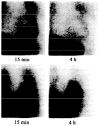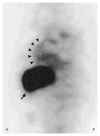Non-invasive imaging and monitoring cardiotoxicity of cancer therapeutic drugs
- PMID: 22351492
- PMCID: PMC3314105
- DOI: 10.1007/s12350-012-9512-2
Non-invasive imaging and monitoring cardiotoxicity of cancer therapeutic drugs
Abstract
Cardiotoxicity due to administration of cancer therapeutic agents such as anthracyclines and herceptin are well described. Established guidelines to screen for chemotherapy-related cardiotoxicity (CRC) are primarily based on serial assessment of left ventricular (LV) ejection fraction (EF). However, other parameters such as LV volume, diastolic function, and strain may also be useful in screening for cardiotoxicity. More recent advances in molecular imaging of apoptosis and tissue characterization by cardiac MRI are techniques which might allow early detection of patients at high risk for developing cardiotoxicity prior to a drop in EF. This comprehensive multi-modality review will discuss both the current established imaging techniques as well as the emerging technologies which may revolutionize the future of screening and evaluation for CRC.
Figures







Similar articles
-
Scintigraphic techniques for early detection of cancer treatment-induced cardiotoxicity.J Nucl Med. 2011 Apr;52(4):560-71. doi: 10.2967/jnumed.110.082784. Epub 2011 Mar 18. J Nucl Med. 2011. PMID: 21421717 Review.
-
Traditional and novel methods to assess and prevent chemotherapy-related cardiac dysfunction noninvasively.J Nucl Cardiol. 2013 Jun;20(3):443-64. doi: 10.1007/s12350-013-9707-1. J Nucl Cardiol. 2013. PMID: 23572315 Review.
-
Left ventricular mechanical dyssynchrony after chemotherapy in breast cancer patients with normal rest gated SPECT-MPI.Ann Nucl Med. 2024 Apr;38(4):272-277. doi: 10.1007/s12149-023-01897-y. Epub 2024 Jan 20. Ann Nucl Med. 2024. PMID: 38244106
-
Cardiotoxicity evaluation using magnetic resonance imaging in breast Cancer patients (CareBest): study protocol for a prospective trial.BMC Cardiovasc Disord. 2020 Jun 3;20(1):264. doi: 10.1186/s12872-020-01497-y. BMC Cardiovasc Disord. 2020. PMID: 32493217 Free PMC article.
-
SPECT and PET MPI: The future has arrived but it is unevenly distributed.J Nucl Cardiol. 2020 Apr;27(2):417-418. doi: 10.1007/s12350-019-02005-2. Epub 2019 Dec 24. J Nucl Cardiol. 2020. PMID: 31875286 No abstract available.
Cited by
-
Vascular Damage - Coronary Artery Disease.J Cardiovasc Echogr. 2020 Apr;30(Suppl 1):S11-S16. doi: 10.4103/jcecho.jcecho_3_19. Epub 2020 Apr 10. J Cardiovasc Echogr. 2020. PMID: 32566461 Free PMC article. Review.
-
Challenges in Cardiovascular Imaging in Women with Breast Cancer.Curr Cardiol Rep. 2023 Oct;25(10):1247-1255. doi: 10.1007/s11886-023-01941-3. Epub 2023 Aug 29. Curr Cardiol Rep. 2023. PMID: 37642930 Review.
-
Cardiac complications of chemotherapy: role of imaging.Curr Treat Options Cardiovasc Med. 2014 Apr;16(4):296. doi: 10.1007/s11936-014-0296-3. Curr Treat Options Cardiovasc Med. 2014. PMID: 24519487 Free PMC article.
-
Noninvasive early detection of anthracycline-induced cardiotoxicity in patients with hematologic malignancies using the phased tracking method.Cancer Med. 2016 Sep;5(9):2276-85. doi: 10.1002/cam4.813. Epub 2016 Aug 3. Cancer Med. 2016. PMID: 27484957 Free PMC article.
-
Anthracycline- and trastuzumab-induced cardiotoxicity: a retrospective study.Med Oncol. 2016 Jul;33(7):82. doi: 10.1007/s12032-016-0797-x. Epub 2016 Jun 22. Med Oncol. 2016. PMID: 27334792 Free PMC article.
References
-
- Horenstein MS, Vander Heide RS, L’Ecuyer TJ. Molecular basis of anthracycline-induced cardiomyopathy and its prevention. Mol Genet Metab. 2000;71:436–44. - PubMed
-
- Tokarska-Schlattner M, Zaugg M, Zuppinger C, Wallimann T, Schlattner U. New insights into doxorubicin-induced cardiotoxicity: The critical role of energetics. J Mol Cell Cardiol. 2006;41:389–405. - PubMed
-
- Von Hoff DD, Layard MW, Basa P, Davis HL, Von Hoff AL, Rozencweig M, et al. Risk factors for doxorubicin-induced congestive heart failure. Ann Intern Med. 1979;91:710–7. - PubMed
-
- Wojnowski L, Kulle B, Schirmer M, Schlüter G, Schmidt A, Rosenberger A, et al. NAD(P)H oxidase and multidrug resistance protein polymorphisms are associated with doxorubicin-induced cardiomyopathy. Circulation. 2005;112:3754–62. - PubMed
-
- Minotti G, Saponiero L, Licata S, Menna P, Calafiore AM, Teodori G, et al. Paclitaxel and docetaxel enhance the metabolism of doxorubicin to toxic species in human myocardium. Clin Cancer Res. 2001;7:1511–5. - PubMed
Publication types
MeSH terms
Substances
Grants and funding
LinkOut - more resources
Full Text Sources
Other Literature Sources
Medical

